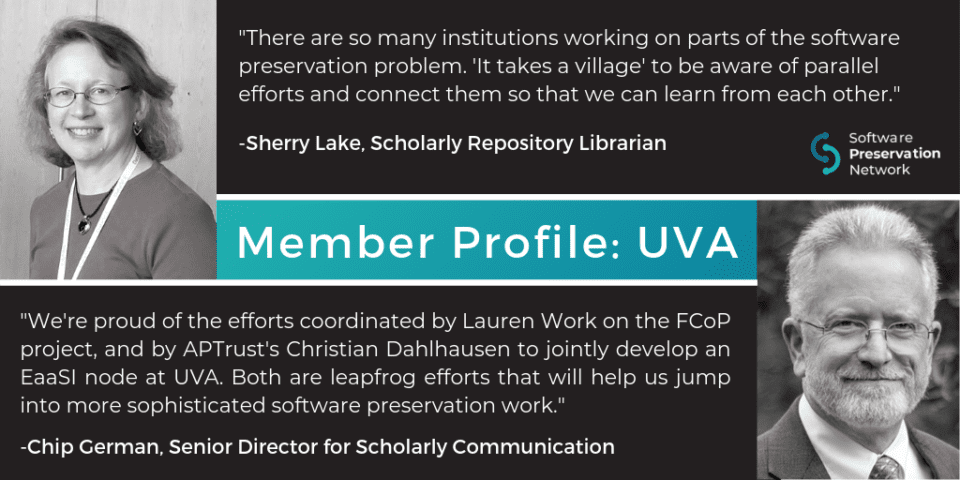Tell us about the software preservation program at your organization.
Sherry: “UVA is increasingly committed to software preservation from an archival and preservation view, thanks in large part to a growing group of Library staff members involved in the Software Preservation Network (SPN). Among them, Lauren Work, UVA’s Digital Preservation Librarian, is tackling the topic head-on as she leads the development of a software preservation program for our Library.”
What has your organization accomplished recently that you’re proud of – big or small?
Chip: “We’re very proud of the efforts coordinated by Lauren on the ‘Fostering a Community of Practice‘ (FCoP) project, and those coordinated by APTrust’s Christian Dahlhausen (along with UVA Library IT folks) to jointly develop an EaaSI node at UVA. Both are leapfrog efforts that will help us jump into more sophisticated software preservation work.”

Tell us about a challenge that your organization is facing in its software preservation work or that the field is facing as a whole?
Chip: “Our challenges are ones that we know are shared by our colleagues around the country and the world. For example, there’s a hurdle to overcome in generalizing the sense among librarians that software preservation is something that deserves professional-level attention at the local level, instead of simply biding our time to apply the results of work done elsewhere. And, we struggle to get our research faculty to focus on managing their research (including data and software) for sharing.”
Sherry: “From a personal perspective, I want our faculty to share all parts of their research, and then the Library can work on how to preserve it. Given that I come to SPN from a Data (Research) Management background, I don’t think of software as a commercial product, but instead, as individual researchers ‘code.’ Of course, the code may be dependent on commercial products, so it all really ties together in a complex matrix.”
Name a software title or library that is particularly significant for one or more of your user constituencies, and tell us why that title or library is particularly significant.
Chip: “All software tools related to 3D data are significant to our Library, and many are vulnerable to the double risks of vendor lock-in and rapid obsolescence. These tools are growing rapidly in importance to many of the top fields of research at UVA.”
Why is collective action the best approach to software preservation?
Chip: “Collective action is the best approach to software preservation because the challenge is too big and diverse for single institutions—if we’re going to make timely strides in progress, it will be because we will have figured out how to collaborate and coordinate across institutions and all the other stakeholders working on it.”
Sherry: “Yes, there are so many institutions and groups working on different parts of the problem. No single group can do it all. ‘It takes a village’ to be aware of parallel efforts and connect them so that we can share with and learn from each other.”